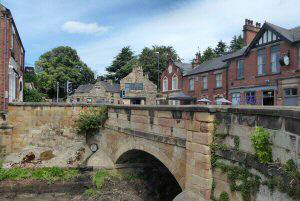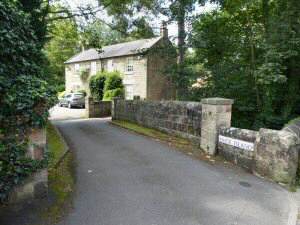DUFFIELD

INFORMATION
Where is it? – Duffield is 5 miles north of Derby on the A5 road.
What to do? – Explore the Millennium Nature Reserve, off Donald Hawley Way which was created as part of the village’s Millennium celebrations. It is an easy stroll from the village centre with good paths and information boards to help you get the best out of your visit – visit what remains of Duffield Castle off the A6 between Castle Hill Road and Avenue Road. Now in the hands of the National Trust – take a ride to Wirksworth and back on the Ecclesbourne Valley Heritage Railway.
Where to eat? – There are several pubs and restaurants to enjoy refreshments.
Other places to visit -For those with time to explore Belper a picture quickly emerges of a small town so rich in industrial heritage that it is not only of national importance but occupies a pre-eminent position on the world stage. Belper is indeed an important part of the Derwent Valley, which is universally recognised as the Cradle of the Industrial Revolution and now holds World Heritage Status. In 2014, Belper won the hugely prestigious ‘Great British High Street’ award. The judges said it was an example of how town centres can be transformed – The National Stone Centre occupies an area of disused quarries overlooking Wirksworth and is crossed by the High Peak Trail. Derbyshire is the largest quarrying area in the country, and in the 1990s, it produced 20 million tons of stone a year. This made the county an ideal site for the National Stone Centre, an educational charity supported by over eighty public, industrial and academic organisations – The small market town of Wirksworth does not perhaps make much impact on the busy traveller driving through. All those visitors, however, with time to explore the narrow streets and maze of interesting alleyways. To admire the old buildings and lovely views, to visit the ancient church and its cathedral-like close, will soon find themselves falling in love with this fascinating old town.


PROFILE
Duffield is a large prosperous mainly residential village with some elegant Victorian and Georgian buildings. These have been added to in more recent times by a significant number of attractive modern houses. The village is well provided with a wide range of shops and other facilities. It is thought that there may have been a settlement in Duffield, close to the junction of the rivers Derwent and Ecclesbourne, since Roman times. Roman pottery was produced at nearby Hazelwood and the river crossing at Milford was also used in those times. Located along the A6, Duffield Hall is an imposing-looking building. It has had a substantial number of owners and was acquired as the Head Office of the Derbyshire Building Society in the 1970s, but financial problems led to its takeover by the Nationwide Building Society and ultimate closure. It is currently in private hands.
Chevin Golf Club, which winds its way up the hillside towards the Chevin was opened on 13 October 1894 as a nine-hole course. Today, the course covers 18 holes with magnificent views over five counties from Chevin Ridge. The initial planning for the golf course took place at Court House Farm, where prisoners were once locked up to await their verdict. Nearby is the 13th hole on the course named ‘The Gibbet.’ The prisoners would not have been amused.
St Alkmund’s Church

The Parish church of St Alkmund at Duffield stands in the water meadows of the River Derwent, a short distance from the village centre, close to the busy, main Sheffield, Derby to London Railway Line. The footbridge over the line provides an excellent viewing point for enthusiasts and interested spectators. It is thought that it is positioned so far from the village that in Anglo-Saxon times it served travellers crossing the river. Nearby, Duffield Bridge was built across the river, next to the Bridge Inn. The bridge was widened in the 18th century and became the main road to the north.
Duffield Hall
Duffield Hall is an imposing-looking building. It has had a substantial number of owners and was acquired as the Head Office of the Derbyshire Building Society in the 1970s, but financial problems led to its takeover by the Nationwide Building Society and ultimate closure. It is now in private hands.
Duffield Castle
Little remains of what was once a substantial castle which had it been completed would have been comparable with the White Tower in London. Located in a commanding position it was built to protect the hunting grounds of Duffield Frith. It is owned and maintained by the National Trust and can be accessed by a flight of steps leading up from the A6 road.

Eyes Meadow
The 40-acre site lies between the mainline railway and the River Ecclesbourne. It was purchased by Duffield Parish Council in 1974. Duffield Cricket Club already had a pitch there. The remainder except for 10 acres of grazing land was adapted for recreational use and Football and Rugby pitches were introduced.
Millennium Meadow
The former grazing land at Eyes Meadow was turned into an award-winning nature reserve with grassland and wetland as part of Duffield’s Millennium Celebrations. Adjacent to the River Derwent and its tributary the River Ecclesbourne it is ideal for a short stroll. It can be easily reached on foot from the village centre.

Ecclesbourne School
The rise in the village population in recent years has been influenced by Ecclesbourne School and the desire of parents to live in its catchment area. The school has an outstanding record and is amongst the top 25 non-selective state schools in the country. There are also two highly-rated primary schools in the village.
The Railway
The arrival of the railway in 1841 brought jobs and an alternative method of travel to horse-drawn transport. Initially, the line ran from Derby to Leeds but Duffield is now part of the Midland Mainline from London to the North. The coming and the later expansion of the railway meant people from Duffield could look further afield for occupation and income. Today there are two railway stations in the village the Midland Mainline and the Ecclesbourne Valley Heritage Railway.
The Ecclesbourne Valley Railway contributed to the local economy for over 100 years, transporting stone and agricultural products. It started carrying passengers on 1 October 1867 and was used for passengers and freight until 1989, when it closed. After that, the railway was neglected and the line became overgrown. To the north Wirksworth Railway Station Yard also became very untidy, which detracted from the carefully restored town centre. A determined band of volunteers and professionals have now restored the line from Wirksworth to Duffield. It is Derbyshire’s longest heritage railway line. In the summer you can take a steam train ride from Wirksworth Station, up a 1 in 27 incline to Ravenstor and visit the National Stone Centre or just go for a walk.



